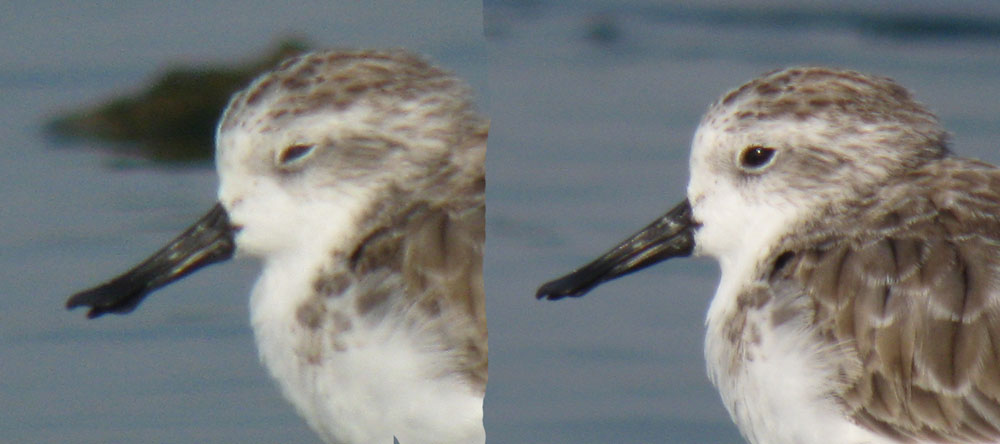The Spoon-billed Sandpiper has one of the most striking and unusual bill shapes of any bird, but the function of the odd spoon-shaped bill has never been determined, and I was particularly interested in watching the birds in Thailand for any clues that might help solve this mystery.

The photo above shows the bill from the side. In the image on the left the tip of the upper mandible is flexed up, as all shorebirds sometimes do, and in this case it reveals some of the odd details of bill shape: the upper mandible is distinctly longer than the lower, and fairly strongly hooked. The spoon shape of upper and lower mandible do not match up exactly, and it appears that the lower mandible “spoon” is offset – slightly closer to the base of the bill. In addition, both the upper and lower mandibles appear very thick and strong. The lower mandible curves up before flattening out into the tip, and the “spoon” is angled up slightly.
Before seeing the birds, most people assume that they use their bills to swipe sideways through the water, in the manner of the true spoonbills (genus Platalea), sensing and grabbing food items as they pass between the flattened tips of the mandibles. But in reality these sandpipers use very little sideways motion in their feeding. There does seem to be a bit more sideways movement of the bill than in other small sandpipers such as Red-necked Stint, but these are subtle, irregular, and tiny movements and nothing like the rhythmic sideways swiping of true spoonbills.
Coming up with a new hypothesis proved difficult. At first I couldn’t detect any difference in the way these sandpipers fed compared to the stints. They do tend to keep their head down and their bill in the water for longer stretches than the Red-necked Stints, which have a more frenetic foraging action dipping their bill briefly into the water and mud and then raising it again, over and over. Also, the Spoon-bills seemed to feed exclusively in water – I never saw one feeding on open mudflats.
After several days of observation I noticed that while their bills were in the water the Spoon-billed Sandpipers were pushing lumps of mud and algae ahead of them, using their bills as shovels to move mud around. They always look a bit “husky” and thick-necked, which comes in part from this habit of pushing the bill through the mud, as they use their body for leverage and push with their legs. It’s not unusual to see one of their feet suddenly slip backwards under the effort of pushing. Once some mud or algae has been lifted the bird very quickly works the bill tip around underneath it, then moves on. This video shows the shoveling motion clearly in the last scene. Another video with more extensive footage of the shoveling motion can be seen in this post.
This seems like a plausible hypothesis to explain the unusual bill shape. The broad bill tip could be used as a shovel to get under and lift up loose substrates, and then would make an effective tool for finding and grabbing any small invertebrates that were in the slurry of mud and water flowing in behind the lifted material. This could also explain why they cover so much ground on the mudflats. If they are looking for loose bits of mud/algae/etc. that they can lift to search for prey, these might be scattered across a wide area, forcing them to walk in search of these foraging opportunities.
It should be pointed out that this is mostly speculation, my observations involved only a few birds at this one wintering site, and only at the high tide roost, so this may not be typical foraging habitat or typical behavior for Spoon-billed Sandpipers. It is possible that at some other sites, especially on migration or on the breeding grounds, other prey or other foraging methods make use of the spoon-shaped bill in different ways. But it would be very interesting to watch for this shoveling behavior in other places and to hear about other observations.
Interestingly, Sauppe at al. (1978; Am. Birds 32:1062-1064), describing the lone British Columbia record, say that bird tended to “rush about more rapidly than the associated Western Sandpipers” and at low tide the Spoon-billed flew alone out of the high tide roost and towards the exposed mudflats. Both of these descriptions could be interpreted as similar to my observations in Thailand.


Fascinating. Thanks for publishing. I had read somewhere that they have been observed using their bills to ‘pat’ wet mud until it ‘liquifies’ but can’t remeber where I read this. There certainly was no detailed description of this behaviour or video footage to back it up and may just have been speculation. When I see one (!), I will let you know.
Fantastic video! A pushing-forward technique seems to be a horizontal counterpart to the Stint’s vertical probing.
Magical!
When I have seen this species foraging I have also noticed a marked preference for feeding in shallow pools/puddles of water on the mudflat too so I think this is generally true for the species. My experience in on the migration stops around the Yellow Sea.
Hi,
Wonderful observations. Nice documentation too. It is sad that this unique Sandpiper is Critically Endangered. I would love to see & photograph this beautiful bird. Any help for getting to the Spoon-billed Sandpiper will be appreciated.I stay in the western part(Maharashtra state) of India. Contact me on – vishwatejpawar@gmail.com
Regards,
Vishwatej Pawar
Pingback: Extremely rare ‘spoonie’ bird added to ark of imperiled animals - NetWorthyNews